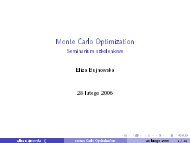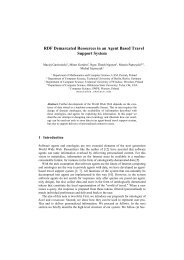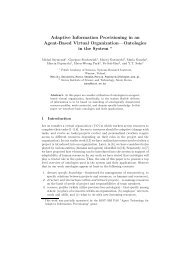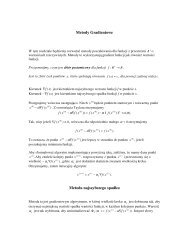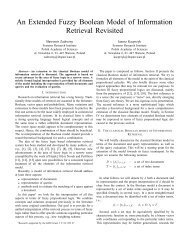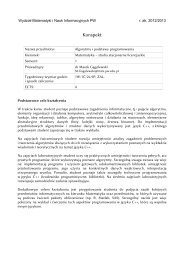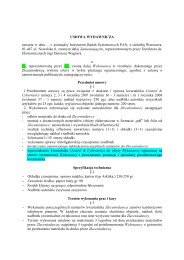Knowledge Management in an E-commerce System
Knowledge Management in an E-commerce System
Knowledge Management in an E-commerce System
You also want an ePaper? Increase the reach of your titles
YUMPU automatically turns print PDFs into web optimized ePapers that Google loves.
<strong>Knowledge</strong> <strong>M<strong>an</strong>agement</strong> <strong>in</strong> <strong>an</strong> E-<strong>commerce</strong> <strong>System</strong> 5knowledge. As the amount of data stored <strong>in</strong> local databases <strong>an</strong>d other electronic repositories cont<strong>in</strong>ues to <strong>in</strong>crease,techniques for tr<strong>an</strong>sform<strong>in</strong>g this data <strong>in</strong>to <strong>in</strong>formation <strong>an</strong>d then knowledge become more import<strong>an</strong>t. The use of thesetechniques requires much less hum<strong>an</strong> <strong>in</strong>put th<strong>an</strong> traditional expert knowledge extraction. In the ideal situation, the expertsare given only the task of verify<strong>in</strong>g the generated knowledge <strong>an</strong>d controll<strong>in</strong>g the acquisition process. In our approach wewill follow the general structure of knowledge m<strong>an</strong>agement function, which consists of knowledge creation, tr<strong>an</strong>sfer <strong>an</strong>dstorage, <strong>an</strong>d application. We will therefore start from discuss<strong>in</strong>g the sources of data that is tr<strong>an</strong>sformed <strong>in</strong>to <strong>in</strong>formation<strong>an</strong>d then <strong>in</strong>to knowledge (while this is a mental shortcut, we will name these data sources: sources of knowledge).Overall, <strong>in</strong> the context of <strong>an</strong> e-<strong>commerce</strong> system we consider three primary sources of knowledge: users of the system,environment, <strong>an</strong>d experts. We will now address each of these sources <strong>in</strong> some detail <strong>an</strong>d follow with a brief overview ofknowledge acquisition techniques <strong>an</strong>d mech<strong>an</strong>isms.3.1 Users of the systemBecause the process of gather<strong>in</strong>g data from sources with<strong>in</strong> the e-<strong>commerce</strong> system c<strong>an</strong> be automated <strong>an</strong>d operatecont<strong>in</strong>uously, various types of electronic data are the most relied-upon orig<strong>in</strong>al sources of knowledge for the system.These <strong>in</strong>clude the more tr<strong>an</strong>sparent data sources related to customers such orig<strong>in</strong>at<strong>in</strong>g IP logs, cookies stored acrosssessions <strong>an</strong>d verbose <strong>in</strong>formation logs generated by the system dur<strong>in</strong>g <strong>in</strong>teraction with users (which <strong>in</strong>corporate<strong>in</strong>formation about actions, as well as non-actions of the client; the fact that the user did not select a given pop-up-b<strong>an</strong>neradmay be as import<strong>an</strong>t as the fact that she has selected a given photo camera). In addition, there are several directmethods of extract<strong>in</strong>g <strong>in</strong>formation from the user, such as questionnaires [9, 21]. From this <strong>in</strong>formation about the customerknowledge c<strong>an</strong> also be extracted about <strong>in</strong>dividual <strong>an</strong>d group behavior, about customs, <strong>in</strong>cl<strong>in</strong>ation, etc. We also need totake <strong>in</strong>to account that the system is <strong>an</strong> <strong>in</strong>termediary between suppliers <strong>an</strong>d customers. In this way one c<strong>an</strong> argue thatwhile to relationship is not completely symmetric, suppliers constitute <strong>an</strong> additional group of users of the system. Mak<strong>in</strong>gthis, slightly controversial assumption, we c<strong>an</strong> conceptualize data collected about suppliers <strong>in</strong> a similar way to that of thedata collected from the customers. Here the data concerns the negotiation processes (auctions), commodity characteristics(prices, amounts, time), data about the quality of delivered commodities (obta<strong>in</strong>ed from customers <strong>an</strong>d matched withsuppliers), number of product returns, reaction time to our requests etc. From this data we gather the knowledge how toconduct the negotiation, with whom, on what conditions, which products to elim<strong>in</strong>ate or <strong>in</strong>corporate.3.2 The environmentWhile the customers <strong>an</strong>d the suppliers are def<strong>in</strong>itively part of the environment that the system operates <strong>in</strong> (see [9] formore details), we have separated them due to the fact that they provide a very specific <strong>an</strong>d immediately applicable type ofknowledge about the suppliers to the system <strong>an</strong>d the customers (<strong>in</strong>clud<strong>in</strong>g potential customers) of the system itself. Theenvironment is the world <strong>in</strong> which the customers <strong>an</strong>d the suppliers <strong>an</strong>d the system operate <strong>an</strong>d that <strong>in</strong>fluences theiractions. This <strong>in</strong>fluence goes directly to the suppliers <strong>an</strong>d customers <strong>an</strong>d is mediated through them as it <strong>in</strong>fluences thesystem. In the ideal situation the system should be able to consider all factors that <strong>in</strong>fluence the customers <strong>an</strong>d their<strong>in</strong>teractions with the system. The typical examples of such factors are: economic policy, new technology, fashion trends,cultural events, weather, etc. While easy to see that these factors c<strong>an</strong> have <strong>an</strong> import<strong>an</strong>t <strong>in</strong>fluence on the e-<strong>commerce</strong>system, due to their generality they are the most difficult to p<strong>in</strong>po<strong>in</strong>t <strong>an</strong>d to build knowledge about them throughautomatic knowledge acquisition processes.3.3 ExpertsThough knowledge acquisition from hum<strong>an</strong> experts may be a very difficult task, some knowledge may be ga<strong>in</strong>ed <strong>in</strong> noother fashion. Expert knowledge is first extracted (us<strong>in</strong>g st<strong>an</strong>dard techniques) as the basis for the system’s knowledge – afoundation of hum<strong>an</strong> experience-derived assumptions, which the system’s knowledge c<strong>an</strong> grow <strong>an</strong>d evolve upon. As thesystem uses this knowledge to learn <strong>an</strong>d exp<strong>an</strong>d, the experts are still needed to deal with atypical situations, statisticaloutliers, which the automated knowledge techniques have difficulty <strong>in</strong>tegrat<strong>in</strong>g <strong>in</strong>to the system. The task of the system <strong>in</strong>these situations is to provide the hum<strong>an</strong> expert with enough <strong>in</strong>formation to help reach<strong>in</strong>g a correct decision <strong>in</strong> as easy aspossible way. In the next stage this, more <strong>in</strong>tuitive, knowledge is <strong>in</strong>corporated <strong>in</strong>to the system.International Conference on Electronic Commerce Research (ICECR-5)



